Another post from our Eurail summer trip – this time we explore Bratislava and its Communist architecture!
Last August, Bratislava was hot. That kind of heat that melts asphalt, leaving footprints where you go. The heat that burns your skin and makes you yearn for air-conditioned safety. Summer 2015 was hot pretty much everywhere, but two places come to mind when thinking back to those searing months – Cologne and Bratislava.
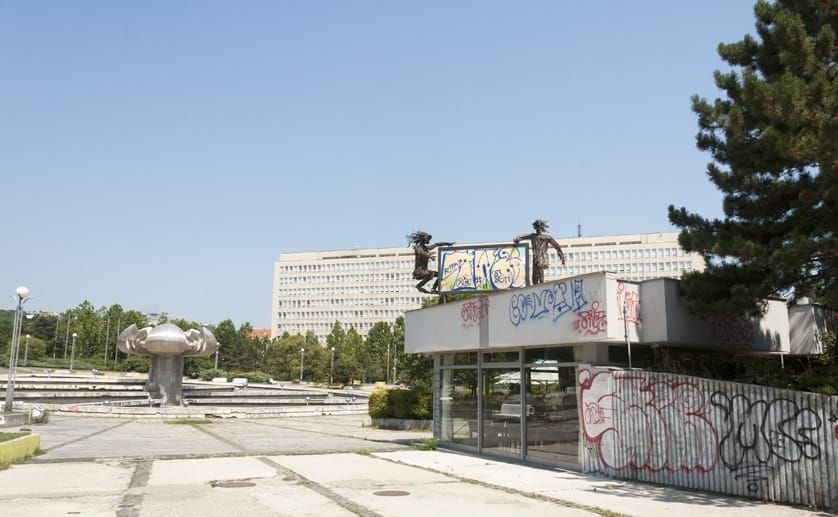
I had been asking friends and reading up on the Slovakian capital before we left, and the consensus seemed to be that the city was worth a visit for an afternoon or so – perhaps as a day trip from Vienna, to tick ‘Slovakia’ off your list of world countries.
‘It isn’t much’, ‘it certainly isn’t Prague’, ‘you can see all the sights in half a day’; Bratislava feedback was along these lines. And by ‘sights’, the blogs and web pages I read usually meant the castle, the quirky ‘blue church’, the old city and the Danube.

We had been travelling around Europe for over a month at that stage, and sure we didn’t fancy touring yet another old city, with its beer bars, souvenir shops and overpriced tourist grub.
Sure, if you look at it this way (especially in summer, when it’s chockablock with tourists), Bratislava can be seen as ‘just another Prague’. So,what did we do? Did we spend the whole of our two days in the city in our lovely air-conditioned room and hotel spa?
Of course we didn’t. Walking from the station to the Danube, where our hotel was located, we noticed that the city is full of Communist architecture. The streets were empty. The scorching sun shone on the bare concrete blocks, giving the city a post-apocalyptic atmosphere, which in turn magnified the ‘Big Brother’ feel of those towering buildings.
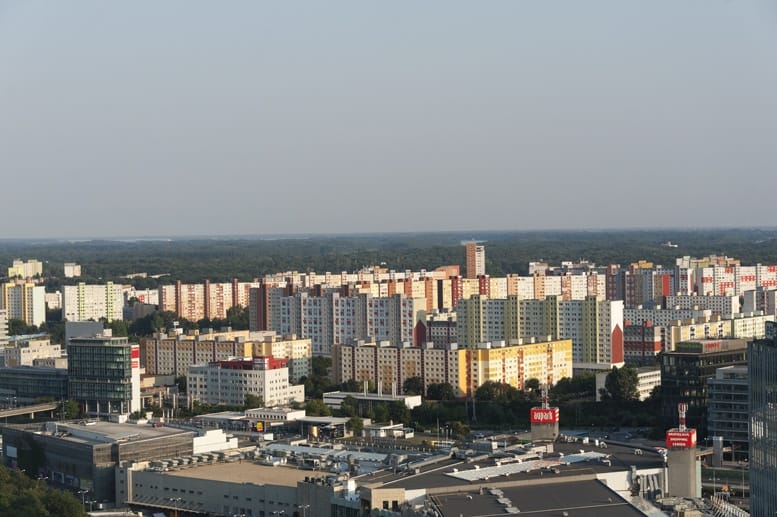
It’s the perfect place, and the perfect day to discover Communist architecture, we thought. So, we pored over blogs and brochures, visited the tourism office and asked around, and designed our very own Bratislava Communist architecture tour.
Several of the places listed in the article were in various states of disrepair and couldn’t be visited from the inside. Which leads me to ask the tourist board, why? Bratislava is certainly not unique when it comes to fin-de-siecle charm – and I am sorry, but Prague and Vienna do it better.
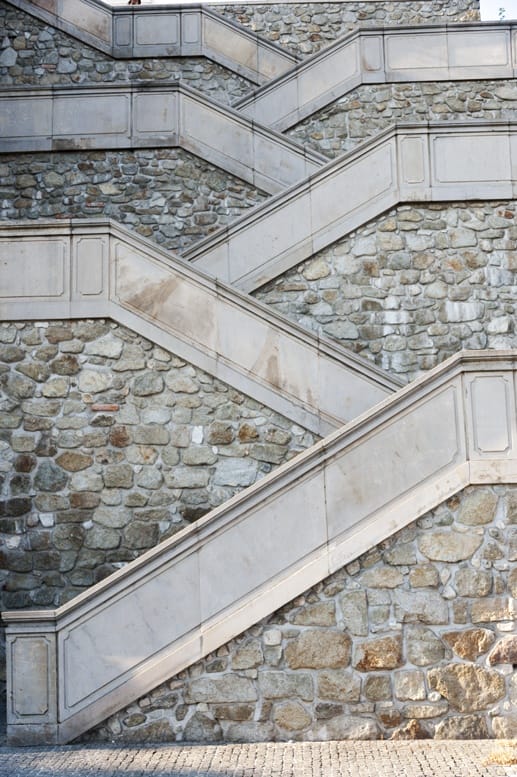
But it is unique in terms of Communist architecture. Which other cities have places like the UFO bridge and the Slovak Radio Building? These should be the in the ‘must see sights’ list, along the Castle and the blue church.
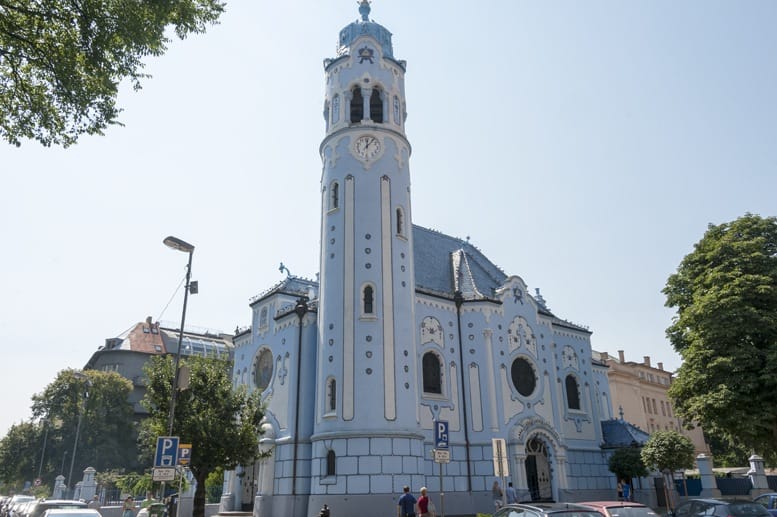
Before I move onto describing the tour, allow me a brief explanation. I do like Communist architecture – that doesn’t mean I share Communist beliefs. I also like Fascist architecture and I most certainly am not a Fascist. When telling my friends from Central/Eastern European countries that I like Communist architecture, sometimes I get harsh reactions, ranging from ‘you don’t know what you’re talking about’ to ‘all Westerners like that, but don’t understand it’.
Architecture, political or not, is a statement of a moment in history, the visible face of cities and the ideologies/circumstances behind their origin and current situation. Communist architecture, treading the fine line between utopia and dystopia, is the face of the second half of the 20th century, whatever trace is left of the ‘age of extremes’. Such buildings may be torn down, sooner or later – but for now, they’re still part of cities, most of them are still used and still inhabited.
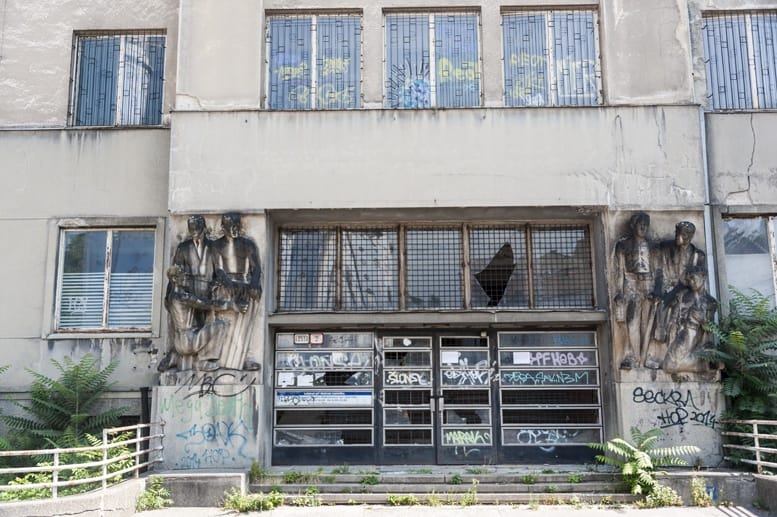
Most importantly, they allow us to understand what happened in that century – that is still so near, and yet so far away.
1. Hotel Kyiev
Our Bratislava communist architecture tour begins with Hotel Kyiev, Bratislava’s very own monster Communist hotel. Every former city beyond the Iron Curtain has (or had) one – Rossiya Hotel in Moscow, Hotel Jalta in Prague, that’s now living a second life as a 5 star property (but still has an underground nuclear fallout shelter).
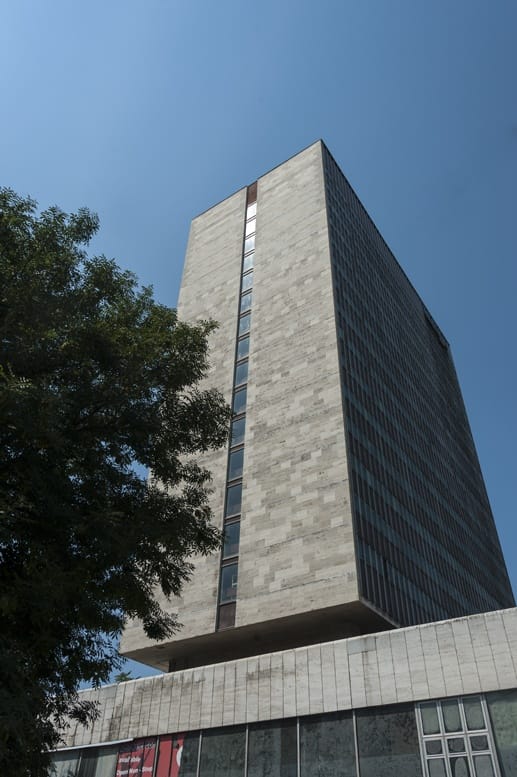
Conversely, Kyiev now lies forgotten, a few minutes walk from Bratislava’s old city. It was briefly opened as a budget hotel – the dusty, faded sign advertising rooms for 19 euro is still visible on the window.
In its heyday, Hotel Kyiev had a futuristic, hyper-modern look, with sleek surfaces and the furnishing of a supervillain’s den – check out this pic of Luna Bar, the exclusive basement bar. Sadly, all furniture was auctioned off in 2012.
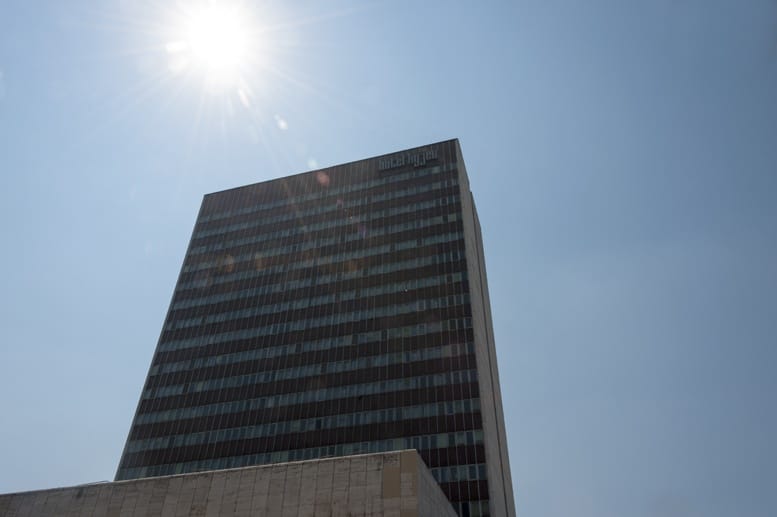
I just wish I got to Bratislava a few years earlier to be able to see this fascinating monster from the inside.
Hotel Kyiev – Rajská 2344/2
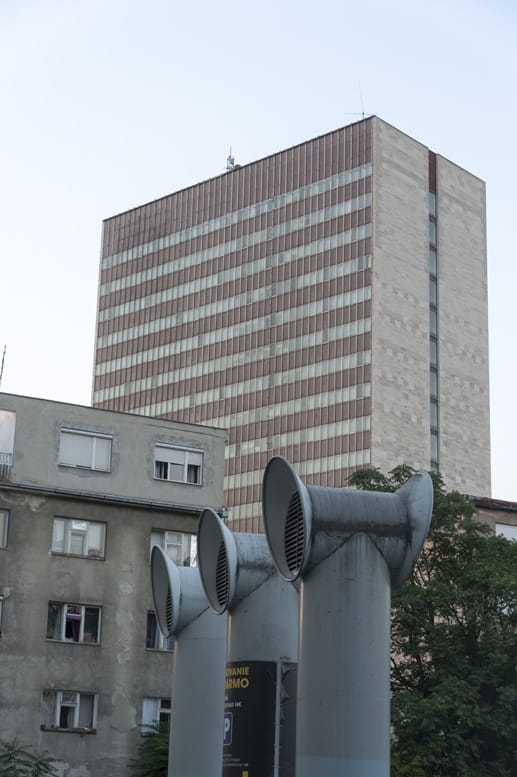
2. Namestie Slobody
Walk north for approximately 10 minutes and you’ll find yourself in the aptly-called Freedom Square, one of the centerpieces of Communist Bratislava and its city planning. It took its present name after the fall of the regime – its Communist name was Gottwaldova, after Czechoslovakia’s first president, Klement Gottwald. There used to be a Gottwald statue, but it was torn down in the 1990s.

There probably have been times in which Gottwaldova / Namestie Slobody would’ve looked cosy, twee even – perhaps on a late May afternoon, with children playing and the crazy-looking flower fountain tinkling in the background.
On a scorching August lunchtime, Namestie Slobody looked like no man’s land. The fountain hasn’t been working since 2007 – apparently it was so badly designed that it became too wasteful to run. The concrete pavement is cracked and full of potholes, tufts of grass grow between one slab and another. Crude graffiti cover the square, the defunct fountain, the bright-yellow benches and a small corrugated-iron building (perhaps a former snack bar that once used to sell warm apricot juice?)

Why come to Namestie Slobody, Margherita? It sounds awful. I must admit that the heat and the sun made it even more surreal, but it’s actually a very interesting place. Two cool buildings surround three of the square’s sides – one is the Post Office Palace, with a paternoster lift still working inside, and the other is the Technical University, built in the 1940s but ’embellished’ by communist graffiti and mosaics.
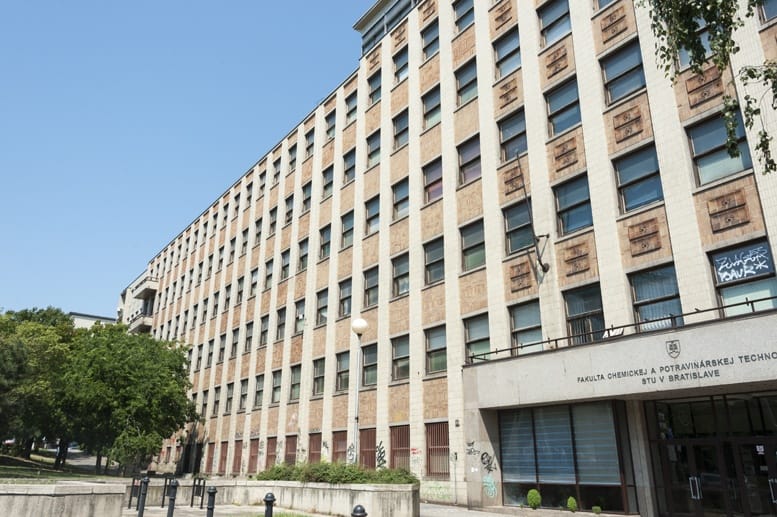
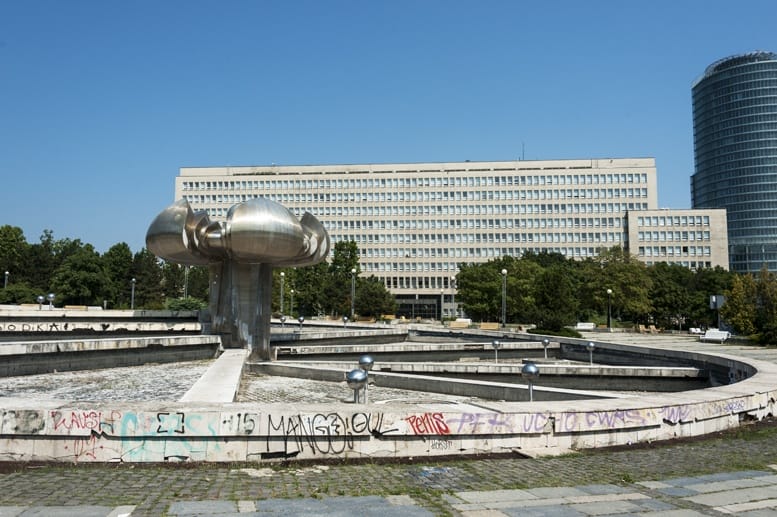
3. Slovenský Rozhlas
Just off Namestie Slobody you’ll find the inverted pyramid of Slovenský Rozhlas, the Slovak Radio Building, believed by many to be the best (and weirdest) Soviet era building. Look at it. What does it remind you of? Yes, at first glance it may just look like an inverted pyramid, but get closer and unleash your inner child… Is it a spaceship? Is it a portal to a new world? Is it the entrance to an underground castle?
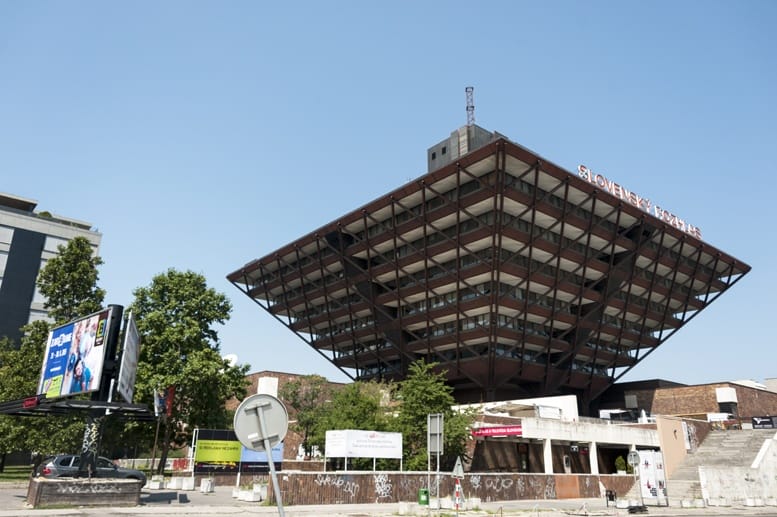
Slovak Radio Building regularly appears in the ‘ugliest buildings in the world’ list, yet it has something amazing about it. Something visionary. It looks futuristic. I wonder how Stefan Svetko, the architect, imagined future to be, and how he would feel these days. Sadly I haven’t been able to find much info on him.
Slovenský rozhlas – Mýtna 1

4. Slavin
Next, retrace your steps to the city centre and catch bus number 147 until you get to a stop called ‘Slavin’, at the bottom of a staircase. Your next destination is right at the top.

Every former Communist city has a Soviet memorial, usually built in the aftermath of WW2 to commemorate Red Army victims and thanking the USSR for ‘freedom’.
Slavin is Bratislava’s very own, standing on top of one of Bratislava’s tallest hills and overlooking the whole of the city – just like an Orwellian Big Brother. The features of Slavin are the same you’ll find in all Soviet memorials – vast, open spaces, straight lines and angular shapes, an iconography that ranges from soldiers kissing the Soviet flag, to the new proud-looking working classes, and culminates in the Soviet hero, holding the flag aloft and crushing a swastika with his mighty boots.
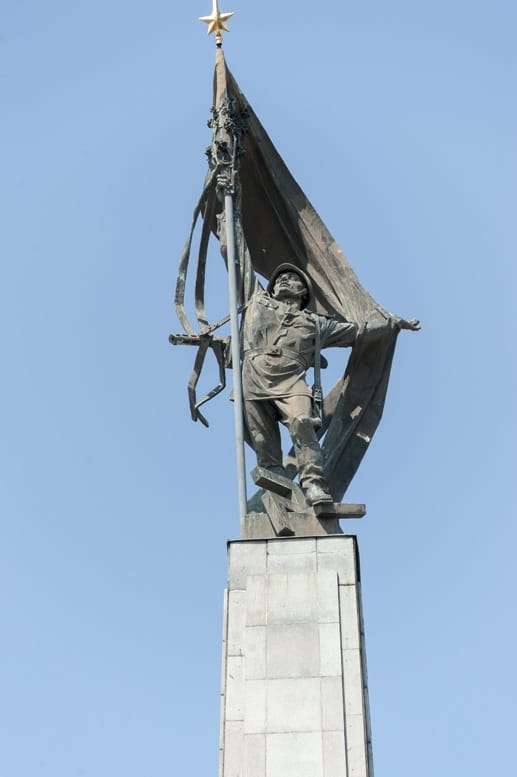
It’s understandable that public opinions about a place like Slavin are ambivalent. The Soviet hero served as a reminder of who was in charge for over 40 years, and now that slobody has arrived (or has it?) what’s the point of a Soviet memorial exactly? I applaud Bratislava for having kept its Soviet memorial and turned it into a public space, just like Berlin did with the memorial at Treptow Park.
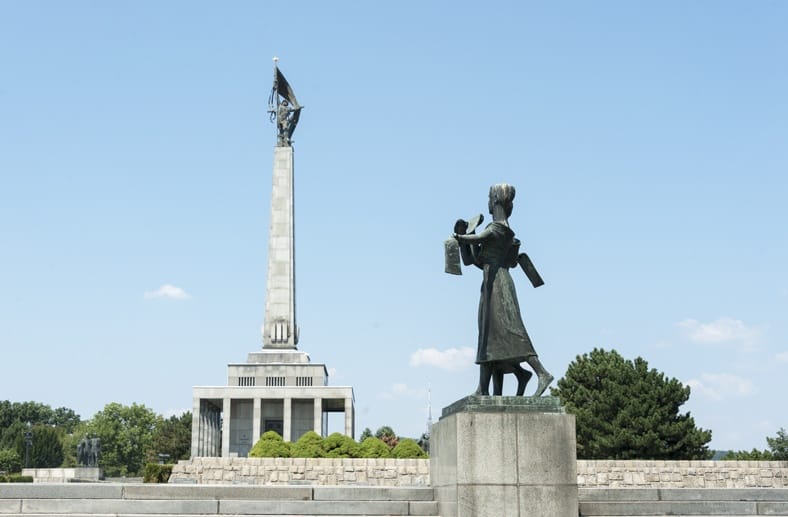
Standing across the open space from the main memorial you’ll notice a needle-looking construction on the hill just behind. This is Kamzik, Bratislava’s television tower, another Communist masterpiece. TV towers are known for being eyesores (think of Prague’s Zizkov for example, even though I do like it) but Kamzik, strangely enough, looks lofty and slender – and quite modern-looking despite having been completed in 1975.

5. UFO Bridge
Take bus n.93 from the station to the old city, walk across it until you get to the Danube. Then, you’ll see it – Most SNP, better known as the UFO bridge, because of its revolving restaurant-cum-viewing platform bearing the uncanny resemblance of a flying saucer, poised to strike and incinerate the whole of Bratislava.
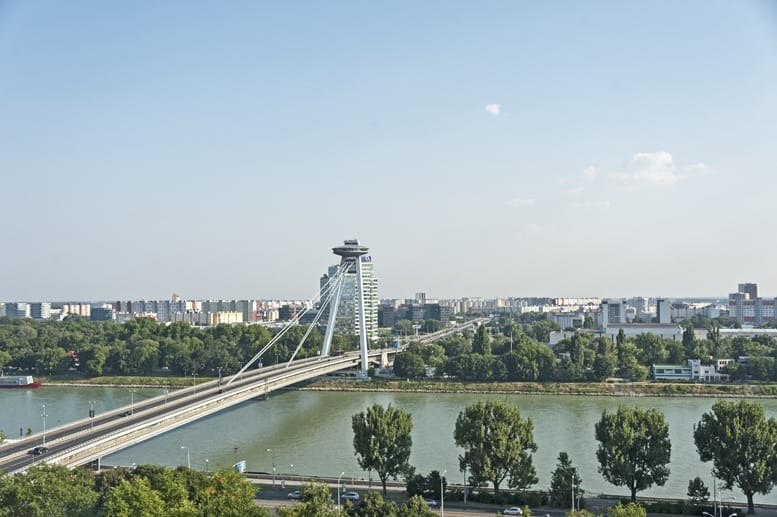
The bridge was built in the 1960s, during the early and optimistic times of Communism, when the regime was all about the future and cadres wanted their cities to look like the setting of sci-fi movies. In this decade, some of the most striking and unique pieces or architecture were produced – like the Federal Assembly Building and the Kotva Department Store.

We highly recommend climbing to the top of the UFO Bridge and having a look at Bratislava’s unique city plan – functionalist buildings on one side (more on this later) and a mishmash of old city, castle hill and some socialist oddities on the other.
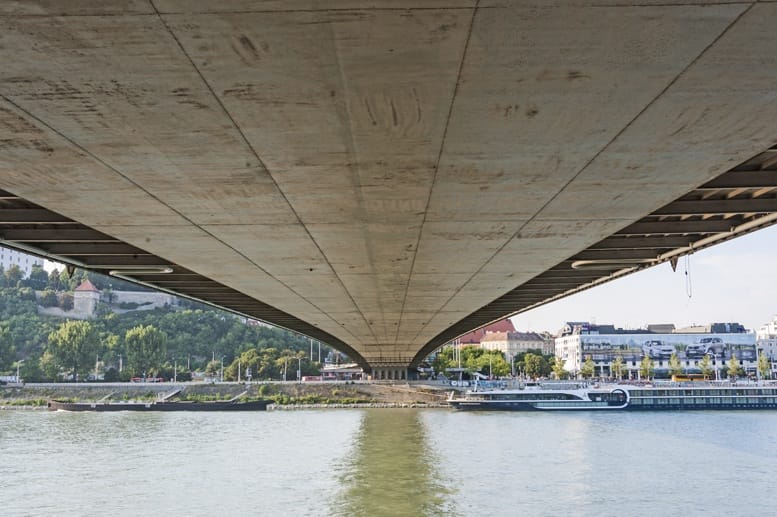
6. Petržalka
The 1960 creative burst came to an end with the Prague Spring, when several architects fell from grace and the regime started promoting functionalist, bare-bones architecture. Looking southwards from the top of the UFO Bridge you’ll notice Petržalka, a neighbourhood made up of square, blocky apartment buildings. These are known in Slovak as panelaks – they’re the iconic Communist time accommodation for the new working classes.
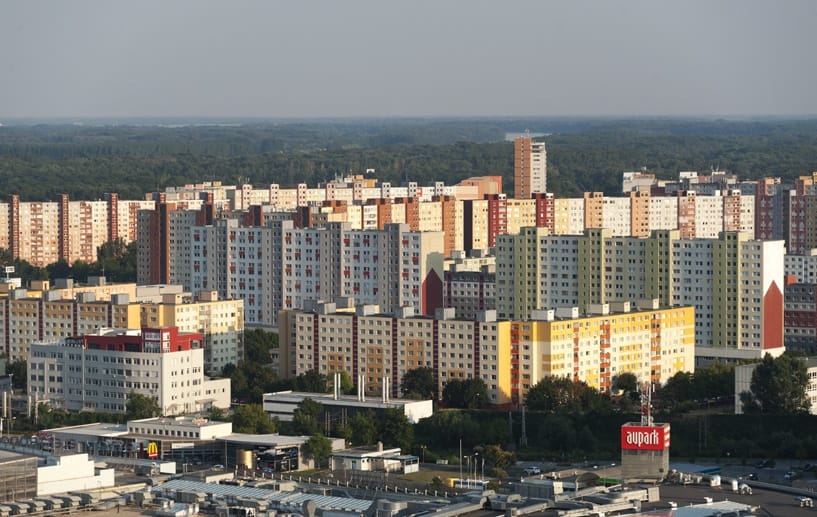
Petržalka is panelak after panelak, a place that looks like the very definition of drab – save for the post-1989 brightly painted concrete façades. Those who, like me, grew up when the wall was still up (or had just fallen) will remember the depictions of Communist life in western books and mags, an existence divided between the factory, queuing for food and living in cramped flats on concrete high-rises (and the lift would never work).
The district was built in the 1970 to house workers of a nearby refinery, and it soon became the most densely state housing development this side of the Iron Curtain. Yet, it was one of the most innovative projects in the whole of Czechoslovakia – besides housing it included transport links, and it was supposed to be surrounded by a network of parks and canals. Needless to say, money ran out. Nowadays,Petržalka is still inhabited by over 100,000 people – sadly, we didn’t have time to tour the neighbourhood properly, but it’s at the top of our list for when we’ll return to Bratislava.
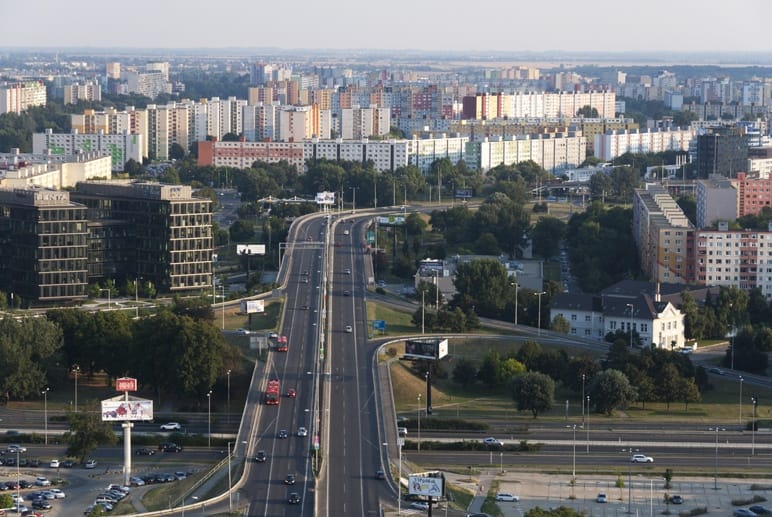
To get to Petržalka, you can use buses number 83, 84 and 93. The neighbourhood is very big, so buses depend of where you want to go. Or you can get an excellent bird’s eye view of the area from the top of the UFO Bridge.
There surely are many other examples of Communist architecture in Bratislava – one scorching summer day was not enough to explore them all.
My only hope now is that they will be properly maintained, and maybe even turned into a tourist drawcard.
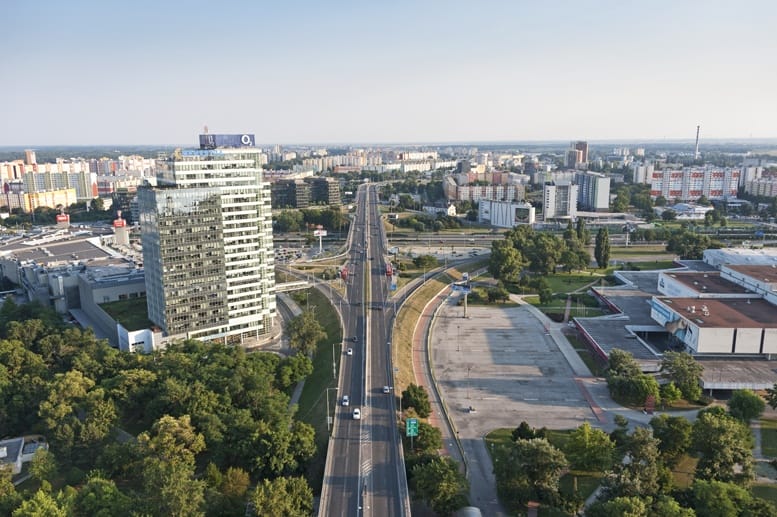

Bratislava City Card
Some of Bratislava’s Communist oddities are found away from the city centre, and especially if you’re visiting in summer or winter, walking around may not be that pleasant.
We found the Bratislava City Card to be a good investment – the 48 hour card is only €12 and it includes unlimited public transport, a free walking tour of the city centre and discounts on tours, museums and restaurants – and you can even get discounted entrance to the UFO bridge viewing platform!

Where to stay in Bratislava
Our Bratislava base was the wonderful Hotel Devin. It’s a luxury property, with a beautiful travertine façade and a great location on the banks of the Danube. We appreciate the high level of service and the little touches everywhere – for instance, a pitcher of ice-cold water with slices of lemon was left in the lobby at all times, so that guests could have a cold drink after wandering the city in the boiling weather.
The room was large and comfortable. We love quirky properties and Devin was very traditional, but we chose to stay there nonetheless because we fancied some comfort after staying in some weird places over the previous weeks (do you remember the forest house we stayed at in the Czech mountains?)
In terms of comfort, Hotel Devin offers all you need – large, fluffy beds with lots of pillows, chilly aircon to keep the annoying heat away, excellent wifi and a breakfast spread to die for, served until 11 am at weekends to let you sleep in (yay!)
The Hotel Devin Spa deserves a special mention. It’s frequently mentioned as one of the best spas in town – and you can get a discount on the entry fee with a Bratislava City Card. There’s a 12 m swimming pool with artificial current (to swim against… or let yourself float), a sauna, steam bath, cooling and rest area. And for all high-flyers (or Eighties nostalgics) there’s even a squash court!
We would like to thank Visit Bratislava for their kind assistance, and Hotel Devin for kindly offering us a media rate. All opinions remain our own.
Pin it for later?
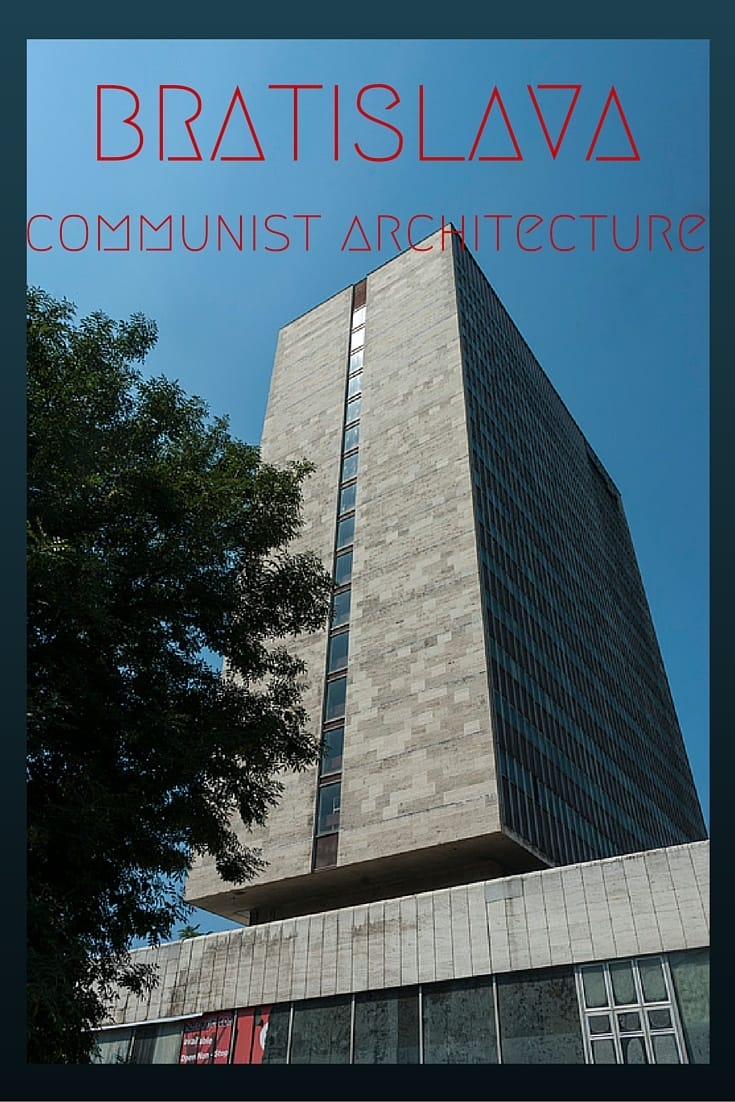

Those are some amazing images. The architecture of the era always reminds me of a sterile hospital scene. Thank you for sharing these images with the world.
Thank you Randy! Glad you liked the post.
I enjoyed your perspective on communist architecture. It reminds of the buildings I saw in what was Eastern Germany shortly after the wall came down. I haven’t been back since so I don’t know if the buildings from that era have been torn down or are still there. They always reminded me of many of the buildings built in the US in the 1950s and I can’t say that I thought they were very attractive.
Thanks Vicki! I believe some of those buildings in East Germany are still up. Do you have pics of your visit? You should blog about it!
Hello,
Its such a nice post.. Its very important.. Thanks to share it.
Thanks!
I am preparing to return to Bratislava in May, 2016. I Googled “alternative archtechture Bratislava” and one of the options was your article. I spent 14 nights there in Sept 2015 and just couldn’t see what I wanted…there is so much!!! Like yourself the main reason for returning is to spend a day, perhaps two or three or four just looking around Petrzalka. I just have to see this area!!
May I suggest an alternative accomodation? It is the Hotel Galleraria at the back of the main railway station…easily recognised by its crazy archtecture.
Happy travels to all, Dougie, U.K.
Thanks so much for your cool tips Douglas! And glad you liked the post. I’ll definitely check out the hotel you recommend next time!
Hey Guys,
I really enjoyed reading your article. I myself blog on similar topics at Marx Get Go so if you like my site and ever want to team up to create some interesting content then please get in touch.
All the best,
Andy
Sure, will do! Thanks!